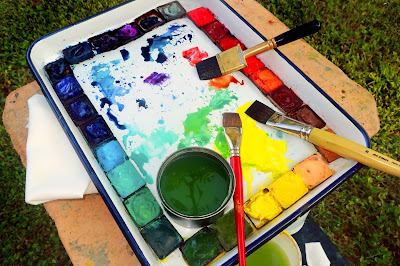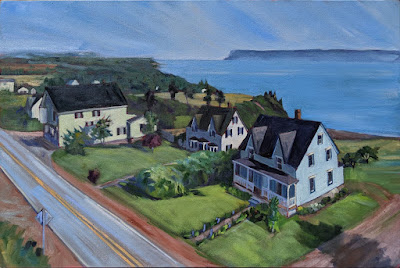The ocean complicates matters by being bouncy, but it reflects light the same way as does glass or tinfoil.
| Tin foil hat, by Carol L. Douglas. Oil on canvasboard. |
Reflections are a distortion of the surrounding environment. That’s true whether you’re painting them in water or from glassware in a still life. Managing them is mainly a question of observation.
Imagine an ocean that is perfectly flat, and that you can walk on water. Looking at your feet, you can see straight down into the water. It’s not reflecting anything. Looking at a rubber ducky floating ten feet away, you’re looking at the surface at about a 26° angle. You’ll see a reflection of the ducky, the sky, and a glimpse of what’s under the surface. As you look farther away, the angle gets smaller and smaller, and all you see is the reflected sky.
| Hard Drive, by Carol L. Douglas, oil on canvasboard. |
Reflection involves two rays – an incoming (incident) ray and an outgoing (reflected) ray. Physics tells us that the angles are identical but on opposite sides of a tangent. This is why the reflection of a boat needs to be directly below the real object in your painting. You can add other colors into that area, but the reflection can’t be wider than the object it’s reflecting.
 |
| The reflection should be directly below the object. Don’t let it grow wider. |
Water is transparent, but it has a shiny surface. Some rays of light make it through and bounce back at us from the sea floor. Reflections in glass work the same way. You can see through the glass in the surface that’s facing you, but the curving sides reflect light from around the room. Because glass is imperfect, these reflections will be distorted.
| My quick watercolor of waves, done from the deck of American Eagle during our Age of Sail workshop. |
The ocean complicates matters by being bouncy. Even on the calmest day, the surface of water is never perfectly flat; it’s wavy or worse, just like a fun-house mirror. Waves are a series of irregular curves. How they reflect light depends on what plane you’re seeing at that nano-second. It seems like the easiest thing to do is to capture it in a photo and paint from that, but what we see in photos is sometimes very different from what we perceive in life.
Instead, sit a moment with and watch how patterns seem to repeat. They’re never exactly the same, since waves are a stochastic process. But they’re close enough to discern general patterns.
| Butter, by Carol L. Douglas, oil on canvasboard. Even something as transparent as Saran Wrap will have reflections. |
Solid objects can also trip you up in their reflections. Consider the humble spoon. It’s concave. That distorts its reflections. There’s no point in trying to predict what you might see; it’s best to just look. Likewise, a mirror only reflects straight back at you if you’re in front of it.
It’s always best to paint the reflections at the same time you’re doing the rest of the painting, rather than adding them as an afterthought. They’re a fundamental part of the design.
Only smooth surfaces reflect light coherently enough to make reflections. That’s why burlap has no reflections. Sometimes, when water is being wind-whipped, it doesn’t have reflections either. To paint such a sea, keep the contrast low.
 |
| Ottawa House, by Carol L. Douglas, oil on canvasboard, available. The wind-whipped sea has very little contrast, but it does have texture. |
Some people say that reflections should be lower in chroma than their objects, but I don’t think that’s true. Often, the ocean seems to concentrate color. Sometimes, the water will be lightest at the horizon; other days there will be a deep band there. However, the farther away, the more its colors shift toward blue-violet.
Your assignment is to make and paint a tinfoil hat (which is very useful in an election year). Your tinfoil will become a little battered and less reflective in places as you fold it. Work fast. Make your neutral greys using complements, not black.
Expect that your painting will look disjointed until you finish. Don’t overwork it. This is an exercise where rough brushwork is a virtue.





































